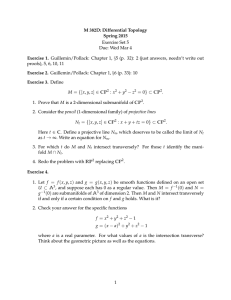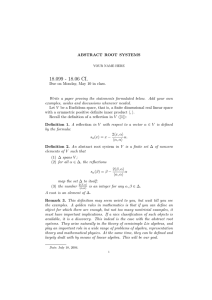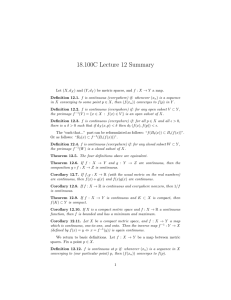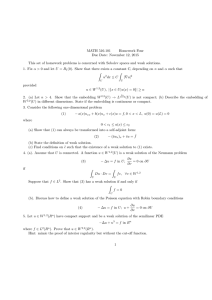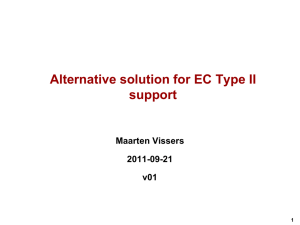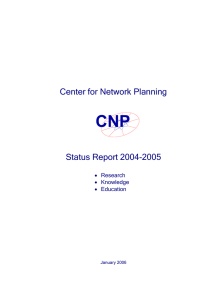SYMPLECTIC GEOMETRY, LECTURE 24
advertisement
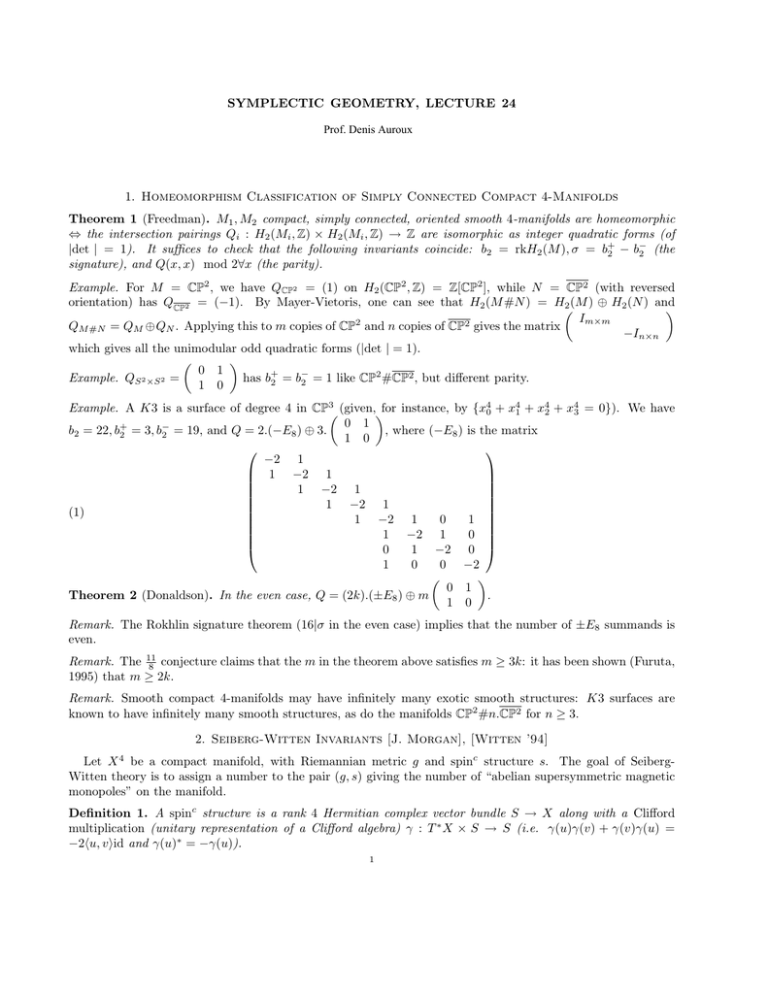
SYMPLECTIC GEOMETRY, LECTURE 24
Prof. Denis Auroux
1. Homeomorphism Classification of Simply Connected Compact 4-Manifolds
Theorem 1 (Freedman). M1 , M2 compact, simply connected, oriented smooth 4-manifolds are homeomorphic
⇔ the intersection pairings Qi : H2 (Mi , Z) × H2 (Mi , Z) → Z are isomorphic as integer quadratic forms (of
−
|det | = 1). It suffices to check that the following invariants coincide: b2 = rkH2 (M ), σ = b+
2 − b2 (the
signature), and Q(x, x) mod 2∀x (the parity).
Example. For M = CP2 , we have QCP2 = (1) on H2 (CP2 , Z) = Z[CP2 ], while N = CP2 (with reversed
orientation) has QCP2 = (−1). By Mayer-Vietoris, one can see that H2 (M #N ) = H�
2 (M ) ⊕ H2 (N ) and
�
Im×m
2
QM #N = QM ⊕QN . Applying this to m copies of CP and n copies of CP2 gives the matrix
−In×n
which gives all the unimodular odd quadratic forms (|det | = 1).
�
�
0 1
−
2
2
Example. QS 2 ×S 2 =
has b+
2 = b2 = 1 like CP #CP , but different parity.
1 0
Example. A K3 is a surface of degree 4 in CP3� (given,�for instance, by {x40 + x14 + x24 + x34 = 0}). We have
0 1
−
b2 = 22, b+
, where (−E8 ) is the matrix
2 = 3, b2 = 19, and Q = 2.(−E8 ) ⊕ 3.
1 0
⎛
⎞
−2 1
⎜ 1 −2 1
⎟
⎜
⎟
⎜
⎟
1 −2 1
⎜
⎟
⎜
⎟
1 −2 1
⎜
⎟
(1)
⎜
0
1 ⎟
1 −2 1
⎜
⎟
⎜
0 ⎟
1 −2 1
⎜
⎟
⎝
0
1 −2 0 ⎠
1
0
0 −2
�
�
0 1
Theorem 2 (Donaldson). In the even case, Q = (2k).(±E8 ) ⊕ m
.
1 0
Remark. The Rokhlin signature theorem (16|σ in the even case) implies that the number of ±E8 summands is
even.
Remark. The 11
8 conjecture claims that the m in the theorem above satisfies m ≥ 3k: it has been shown (Furuta,
1995) that m ≥ 2k.
Remark. Smooth compact 4-manifolds may have infinitely many exotic smooth structures: K3 surfaces are
known to have infinitely many smooth structures, as do the manifolds CP2 #n.CP2 for n ≥ 3.
2. Seiberg-Witten Invariants [J. Morgan], [Witten ’94]
Let X be a compact manifold, with Riemannian metric g and spinc structure s. The goal of SeibergWitten theory is to assign a number to the pair (g, s) giving the number of “abelian supersymmetric magnetic
monopoles” on the manifold.
4
Definition 1. A spinc structure is a rank 4 Hermitian complex vector bundle S → X along with a Clifford
multiplication (unitary representation of a Clifford algebra) γ : T ∗ X × S → S (i.e. γ(u)γ(v) + γ(v)γ(u) =
−2�u, v�id and γ(u)∗ = −γ(u)).
1
Prof. Denis Auroux
2
Example. For {ei } an orthonormal basis, γ(ei ) ∈ U (S), since γ(ei )2 = −1, and γ(ei )γ(ej ) + γ(ej )γ(ei ) = 0.
We extend our Clifford multiplication to
�
∗
(2)
γ:
(T ∗ X) × S → S, γ(ei1 ∧ · · · ∧ eip ) = γ(ei1 ) · · · γ(eip )
for (ei ) orthonormal. Applying this to the volume form gives γ(vol)2 = (γ(e1 )γ(e2 )γ(e3 )γ(e4 ))2 = id and thus
a decomposition S = S + ⊕ S − , with the former having γ(vol) = −1 and the latter γ(vol) = 1. Moreover, γ(ei )
maps S ± to S � .
∼
Lemma 1. We can represent complexified forms via γ : ∧∗ ⊗ C → End(S + ⊕ S − ). More specifically, we have
decompositions
∧even ⊗ C ∼
= End(S + ) ⊕ End(S − )
(3)
∧odd ⊗ C ∼
= Hom(S + , S − ) ⊕ Hom(S − , S + )
with γ(∗α) = γ(α) on S + and −γ(α) on S − for any α ∈ ∧2 , so
End(S + ) = C ⊕ (∧2+ ⊗ C), End(S − ) = C ⊕ (∧2− ⊗ C)
(4)
Theorem 3. Every compact 4-manifold admits spinc structures classified up to 2-torsion by c = c1 (S + ) =
c1 (S − ) = c1 (L) ∈ H 2 (X, Z), where L = det (S + ) = ∧2 S + = ∧2 S − . Moreover, c is a characteristic element, i.e.
�c1 (L), α� ≡ Q(α, α) mod 2.
In particular, if E → X is a line bundle, the mapping (S + , S − ) �→ (S + ⊗ E, S − ⊗ E) gives a twisting of the
spinc structure by any line bundle.
Proposition 1. If X admits a g-orthogonal almost-complex structure J, then ∃ a canonical spinc structure
given by S + = ∧0,0 ⊕ ∧0,2 , S − = ∧(0,1) with
√
(5)
∀u ∈ T ∗ X, γ(u) = 2[(u0,1 ∧ ·) − ι(u1,0 )# (·)]
Note that L = ∧2 S − = ∧2 S + = ∧0,2 is the anti-canonical bundle. All other spin structures are given by
S + = E ⊕ (∧0,2 ⊗ E), S − = ∧0,1 ⊗ E, ∀E → X a line bundle.
3. Dirac Operator
c
Definition 2. A spin connection on S
(6)
±
is a Hermitian connection �A s.t.
LC
A
�A
v (γ(u)φ) = γ(�v u)φ + γ(u)�v φ
Proposition 2. Any two spinc connections differ by a 1-form on X of the type ia ⊗ idS ± , and the induced
connection A on L = ∧2 S ± defines the spinc connection uniquely.
Definition 3. Given a spinc structure and a connection, the Dirac operator is
�
DA : Γ(S ± ) → Γ(S ± ), DA ψ =
γ(ei )�A
ei ψ
(7)
i
for {ei } an orthonormal basis (though it is independent of choice of basis).
Example. On a Kähler manifold, S + = E ⊕ ∧0,2 ⊗ E, S −√= ∧0,1 ⊗ E, �A corresponds to a unitary connection
∗
2
�a on E, i.e. via �A = �LC ⊗ 1 + 1 ⊗ �a . Then DA = 2(∂ a + ∂ a ) and DA
= 2�a .
Definition 4. The Seiberg-Witten equations are the equations
(8)
DA ψ = 0 ∈ Γ(S − )
γ(FA+ ) = (ψ ∗ ⊗ ψ)0 ∈ Γ(End(S + ))
where A is a Hermitian connection on L = ∧2 S ± (corresponding to a spinc connection on S ± ), ψ ∈ Γ(S + ) is
2
2
for FA ∈ iΩ2 the curvature of A, and (ψ ∗ ⊗ ψ)0 = ψ ∗ ⊗ ψ − 12 |ψ| is the
a section, FA+ = 21 (FA + ∗FA ) ∈ iΩ+
traceless part of ψ ∗ ⊗ ψ.
